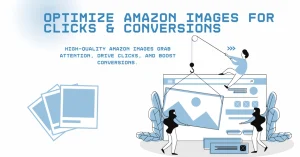How to Analyze Amazon Revenue Growth with Sales Insights?
 Understanding what customers are searching for on Amazon is at the heart of smart selling. For the past five years, I’ve helped sellers connect with real demand by using keyword tools that uncover what shoppers are actively looking for. Market demand isn't a figure that represents consumer intention, interest, and purchasing behavior. If you ignore those indicators, you're going to squander money and time on non-selling products or improve listings that never get seen. The proper keywords will indicate to you where the opportunity lies, what competition you'll face, and what customers anticipate from products like yours. This blog will walk you through what keyword tools do, how to interpret the data, and how to utilize that data for product research and listing optimization. Whether you’re new to Seller Central or scaling, understanding demand through keywords provides clear direction, enable you to make knowledgeable decisions, and get your products to the right buyers at the right time.
Understanding what customers are searching for on Amazon is at the heart of smart selling. For the past five years, I’ve helped sellers connect with real demand by using keyword tools that uncover what shoppers are actively looking for. Market demand isn't a figure that represents consumer intention, interest, and purchasing behavior. If you ignore those indicators, you're going to squander money and time on non-selling products or improve listings that never get seen. The proper keywords will indicate to you where the opportunity lies, what competition you'll face, and what customers anticipate from products like yours. This blog will walk you through what keyword tools do, how to interpret the data, and how to utilize that data for product research and listing optimization. Whether you’re new to Seller Central or scaling, understanding demand through keywords provides clear direction, enable you to make knowledgeable decisions, and get your products to the right buyers at the right time.Key Amazon Seller Metrics to Track for Sales Growth
Knowing what to track instructs sellers to keep their performance on track and make smart decisions. Below is the explanation of the key metrics and how they inform your strategy. </span">| Metric | What It Shows | How It Informs Strategy |
|---|---|---|
| Units Sold | Total products sold in a time frame | Helps track demand, forecast inventory, and identify growth trends |
| Conversion Rate | Percentage of shoppers who bought after viewing | Indicates how well your listing persuades customers; optimize images, title, and description |
| Impressions | How often your listing appears in searches | Helps gauge visibility and keyword effectiveness |
| Sessions | Number of visits to your listing | Measures engagement and helps pinpoint the effectiveness of your ads and promotions |
| Advertising Metrics | Data from sponsored ads like clicks and cost per conversion | Guides ad spend, helps identify top-performing keywords, and improves ROI |
How to Integrate Multiple Tools for a Complete View?
- Use Amazon’s reports for base metrics like orders and inventory
- Supplement with Jungle Scout or Helium 10 for market research and competitor tracking
- Apply Keepa’s price trends to adjust pricing strategies during peak seasons
- Combine data points weekly to spot patterns that single tools might miss
Analyzing Historical Data vs. Real-Time Insights
| Type of Data | What It Helps You Do | When to Use |
|---|---|---|
| Historical Data | Spot long-term patterns and forecast future demand | Best for planning inventory and anticipating seasonal trends |
| Real-Time Insights | Track sudden changes in buyer behavior or competition | Essential during promotions, new launches, or unexpected market shifts |
How to Use Them Together?
- Review sales data from the past 6-12 months to forecast stock requirements
- Use real-time analytics to spot shifts caused by trends, news, or competitor pricing
- Adjust marketing strategies quickly based on customer response patterns
Competitor Analysis: Learning Without Copying
Keeping an eye on competitors helps you sharpen your strategy without simply replicating their approach. Identify Competitor Pricing Strategies- Track when competitors adjust prices and how often they run discounts
- Understand how much flexibility you have in pricing without undercutting yourself
- Monitor competitor reviews to find gaps in customer satisfaction
- Study their new product launches to anticipate market trends
Leveraging Trends for Inventory and Pricing Strategy
Demand Forecasting- Analyze past sales spikes to plan for busy seasons
- Avoid overstocking slow-moving items that tie up capital
- Adjust prices based on competitor activity, customer demand, and market events
- Use automated tools to update pricing in response to fluctuations
Advertising Trends: Using Sponsored Ads Data Effectively
Optimize Ad Spend- Focus on keywords that convert, not just those with high search volume
- Cut back on ads that drive clicks but low conversions
- Shift focus to ads performing well in specific regions or demographics
- A/B test ad copy and placement to see what generates better results
Monitoring Customer Feedback Trends
Use Reviews to Predict Future Buying Behavior- Watch for common praise or complaints that indicate shifting customer expectations
- Anticipate future trends based on feedback about features customers love
- Respond promptly to negative reviews and FAQs
- Update listings to clarify product details customers repeatedly ask about
How Trend Monitoring Saved a Seller from Overstocking?
Tools Used- Amazon Seller Central reports for historical sales
- Jungle Scout for competitor insights
- Keepa for tracking price fluctuations
- A sudden decline in searches for a seasonal product signaled a drop in demand
- Competitor pricing analysis showed aggressive discounting during off-peak times
- Real-time tracking identified an emerging trend toward a new product category
- Adjusted inventory orders by reducing stock by 40%
- Shifted ad spend to new, trending products
- Repriced listings based on competitor moves, improving profitability
- Avoided major stock losses
- Increased overall ROI by 18% in two months
- Built a more resilient inventory planning process for future seasons



Understand Amazon Market Demand with Advanced Keyword Tools
How to Analyze Amazon Revenue Growth with Sales Insights? Understanding what customers are searching for...
Share this link via
Or copy link